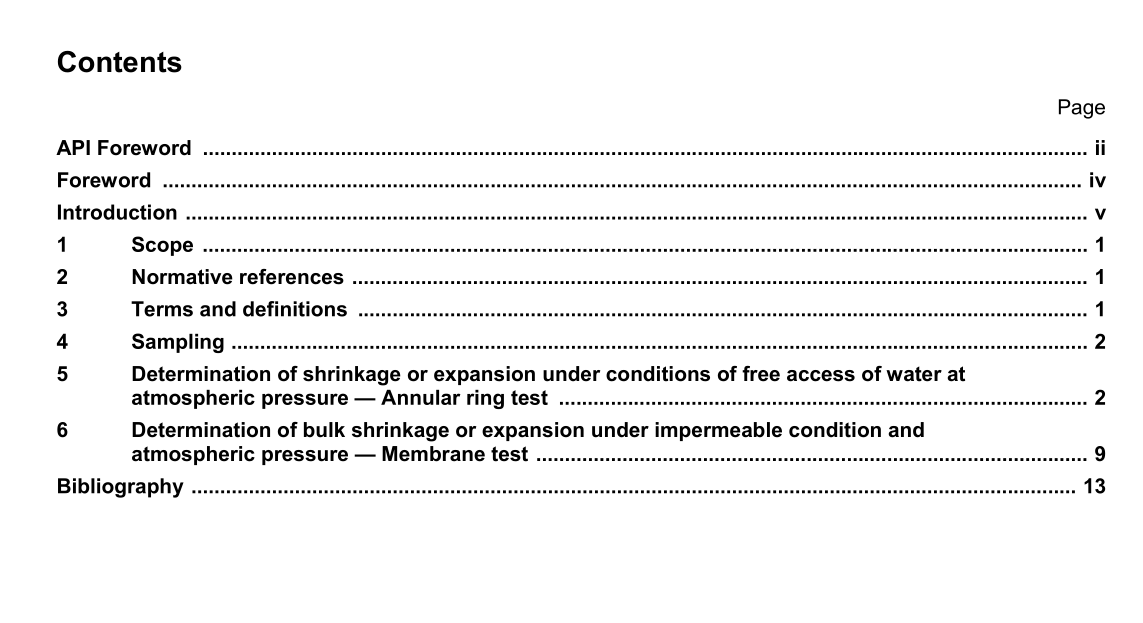ANSI API RP 10B-5 pdf download

ANSI API RP 10B-5 pdf download.Petroleum and natural gas industries — Cements and materials for well cementing
4 Sampling
4.1 General Samples of the neat cement or cement blend, solid and liquid additives, and mixing water are required to test a slurry according to this part of ISO 10426. Accordingly, the best available sampling technology should be employed to ensure the laboratory test conditions and materials match as closely as possible those found at the wellsite. Some commonly used sampling devices are shown in ISO 10426-2:2003, Figure 1. 4.2 Method Applicable sampling techniques for the fluids and materials used are specified in ISO 10426-2:2003, Clause 4.
5 Determination of shrinkage or expansion under conditions of free access of water at atmospheric pressure — Annular ring test
5.1 General information The annular expansion mould is a device suitable for measuring only the linear bulk shrinkage or expansion properties of a cement formulation. The magnitude of expansion depends on the amount of expanding agent, cement powder, slurry design and curing condition (pressure, temperature, time, fluid access). It should be noted that expansion is strongly affected by boundary conditions. The chemical process of mineral growth is strongly controlled by the state of stress and mineral growth will tend to occur where the stress value is the lowest, i.e. in pore space or empty spaces. Therefore, the degree of cement shrinkage and expansion is dependent on a number of conditions, not all of which can be uniquely defined. The test does not represent fully the annulus of a well. 5.2 Apparatus 5.2.1 Mould 5.2.1.1 General Use corrosion-resistant material (e.g. stainless steel). The outer diameter (OD) of the inner ring shall be 50,8 mm (2 in) and the inner diameter (ID) of the outer expansion ring shall be 88,9 mm (3,5 in). See Figures 1, 2 and 3.5.2.1.2 Mould calibration The resilience of the ring of the mould shall be calibrated annually. The resilience shall be such that the mass of 1 000 g ± 1 g (2,204 6 lb ± 0,002 lb) applied as shown in Figure 4 shall increase the distance between the two steel measurement balls (see Figure 9) by 2 mm ± 0,3 mm (0,078 7 in ± 0,011 8 in) without permanent deformation. Attention must be paid to ensure that the load is applied perpendicular to the gap (90°) in order to avoid errors, which might be easily made. The readings shall be repeated at least three times to obtain an average value with a standard deviation of 0,05 mm (0,002 in).5.2.1.3 Spacer block The spacer block shall be used only in the case of shrinkage measurement. It is used to slightly increase the diameter of the outer ring prior to slurry-pouring and to measure shrinkage by removing it once the cement starts to set. The dimensions of the block shall be 3,175 mm × 3,175 mm to 6,35 mm × 6,35 mm (0,125 in × 0,125 in to 0,25 in × 0,25 in) and 22,0 mm (0,866 in) tall; see Figure 3. To ensure that the spacer block’s thermal expansion properties are the same as those of the expandable outer ring, the block shall be made of the same material as the mould (e.g. stainless steel). 5.2.2 Water curing bath A curing bath or tank having dimensions suitable for the complete immersion of a mould(s) in water and which can be maintained within ± 2 °C (± 3 °F) of the prescribed test temperature shall be employed. The curing bath is an atmospheric-pressure apparatus (bath) for curing specimens at a temperature of up to 88 °C (190 °F). It shall have an agitator or circulating system.5.2.3 Cooling bath The cooling-bath dimensions shall be such that the specimen to be cooled from the curing temperature can be completely submerged in water maintained at 27 °C ± 3 °C (80 °F ± 5 °F). 5.2.4 Temperature measuring system The temperature-measuring system shall be calibrated to an accuracy of ± 1 °C (± 2 °F). Calibration shall be no less frequent than monthly. The procedure described in ISO 10426-2:2003, Annex A, is commonly used. 5.2.4.1 Thermometer A thermometer with a range including 21 °C to 100 °C (70 °F to 212 °F) with minimum scale divisions not exceeding 1 °C (2 °F) should be used. 5.2.4.2 Thermocouple A thermocouple system with the appropriate range should be used.









